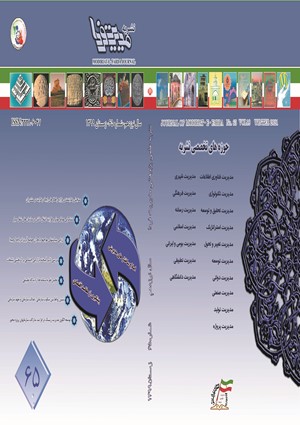Explaining a model for sacrifice based on customer experience in the hotel industry (four and five stars in Shiraz)
Subject Areas :jahanbakhsh rahimi baghmalek 1 , seyed abolghasem mira 2 , Mohammad Haghighi 3
1 - islamic azad university,gachsaran branch
2 - tehran university
3 - tehran university
Abstract :
The purpose of this study was to explain the loyalty model based on customer experience in the tourism industry, especially in the hotel industry, in order to conceptualize loyalty, to examine how the factors of the loyalty model based on customer experience on each other and practical solutions to improve the customer loyalty process in the service sector Especially hospitality. In this research, using the exploratory hybrid design, the concept of loyalty of conceptualization and in the form of a model, the process is explained and extracted. In the first research, the foundation data strategy was used in the form of open, axial and selective coding in the first stage of the design of the model.For this purpose, raw data of deep interviews was gathered with 25 managers, experienced clients and university professors..The results of this research phase, the explanation of 21 categories in 8 categories, describe the quality of hotel staff, the quality of the environment and physical space of the hotel, the quality of hotel service functions, empirical marketing, internal marketing, relationship marketing, customer development, customer empowerment , Tourism industry capabilities, customer perceptions and expectations of the services and provider, multiple value creation for customers, customer reset, customer support from the hotel brand, profit making, improved communication capabilities with customers, increased forecasting power in Future, upgrading service quality, reducing competitors' threats, improving brand credibility, improving quality of service Life, economic and social capital that model paradigm is presented.
[1].Akın, E. (2012). Literature Review and Discussion on Customer Loyalty and Consciousness. European Journal of Economics, Finance and Administrative Sciences, 51, 158-173.
[2].Bhuiyan, M. A. H., Siwar, C., & Ismail, S. M. (2013). Tourism development in Malaysia from the perspective of development plans. Asian Social Science, 9(9), 11.
[3].Borin, N., Cerf, D. C., & Krishnan, R. (2011). Consumer effects of environmental impact in product labeling. Journal of Consumer Marketing, 28(1), 76-86.
[4].Dominici, G., & Guzzo, R. (2010). Customer satisfaction in the hotel industry: A case study from Sicily.
[5].Jiang, H., & Zhang, Y. (2016). An investigation of service quality, customer satisfaction and loyalty in China's airline market. Journal of air transport management, 57, 80-88.
[6].Kazakova, S., Cauberghe, V., & Thijs, D. (2012). The effect of flow on implicit memory of in-game brand placements. In Advances in Advertising Research (Vol. III) (pp. 249-259). Gabler Verlag, Wiesbaden.
[7].Kim, M. K., Wong, S. F., Chang, Y., & Park, J. H. (2016). Determinants of customer loyalty in the Korean smartphone market: Moderating effects of usage characteristics. Telematics and Informatics, 33(4), 936-949.
[8].Maggioni, I. (2016). What drives customer loyalty in grocery retail? Exploring shoppers' perceptions through associative networks. Journal of Retailing and Consumer Services, 33, 120-126.
[9].Rundle-Thiele, S., & Maio Mackay, M. (2001). Assessing the performance of brand loyalty measures. Journal of Services Marketing, 15(7), 529-546.
[10].Shan, B. Y., & Marn, J. T. K. (2013). Perceived critical success factors (CSFS) for the tourism industry of Penang Island: A supply perspective. Interdisciplinary Journal of contemporary research in business, 4, 495-510.
[11].Silva, G. M., & Goncalves, H. M. (2016). Causal recipes for customer loyalty to travel agencies: Differences between online and offline customers. Journal of Business Research, 69(11), 5512-5518.
[12].Simona-Mihaela, T. R. I. F. (2012). Antecedents and consequences of relationship quality. A case study of banking sector in Romania. Timisoara Journal of Economics, 5(18), 253-271.
[13].Srivastava, M., & Kaul, D. (2016). Exploring the link between customer experience–loyalty–consumer spend. Journal of Retailing and Consumer Services, 31, 277-286.
[14].Strauss, A., & Corbin, J. (1998). Basics of qualitative research. 1998. Thousand Oaks.
[15].Triantafillidou, A., & Siomkos, G. (2014). Consumption experience outcomes: satisfaction, nostalgia intensity, word-of-mouth communication and behavioural intentions. Journal of Consumer Marketing, 31(6/7), 526-540.


